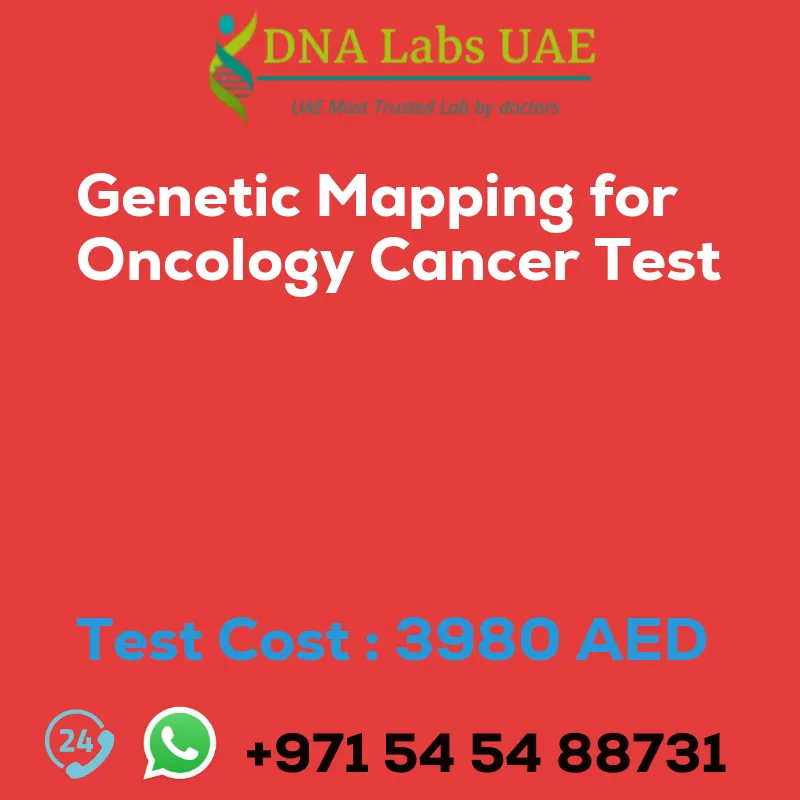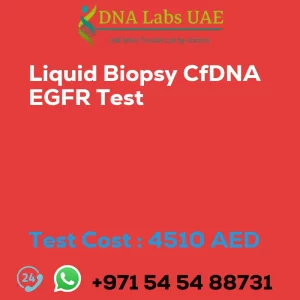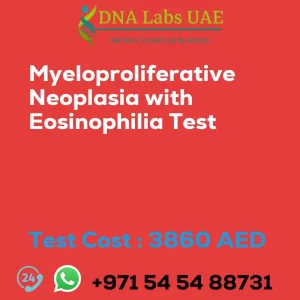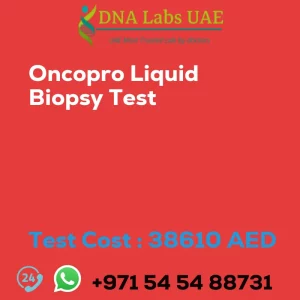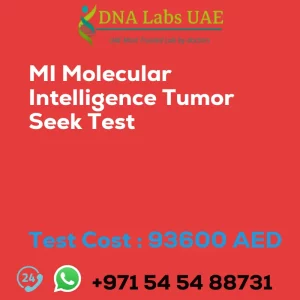Genetic Mapping for Oncology Cancer Test
Test Name: GENETIC MAPPING FOR ONCOLOGY CANCER Test
Components: Price – 3980.0 AED
Sample Condition: Submit 3 mL (2 mL min.) whole blood in 1 Lavender top (EDTA) tube. Ship refrigerated. DO NOT FREEZE. Duly filled Genome Mapping Consent Form (Form 26) is mandatory.
Report Delivery: Sample Daily by 9 am; Report 8 weeks
Method: SNP Genotyping using Microarray
Test type: Cancer
Doctor: Oncologist
Test Department: MOLECULAR DIAGNOSTICS
Pre Test Information: Duly filled Genome Mapping Consent Form (Form 26) is mandatory.
Introduction
Genetic mapping for oncology or cancer testing involves analyzing a person’s DNA to identify specific genetic mutations or variations that may increase their risk of developing cancer or influence their response to cancer treatment. This type of testing is often used to guide personalized treatment decisions and to assess an individual’s risk of developing certain types of cancer.
Methods Used for Genetic Mapping in Oncology
- Next-generation sequencing (NGS): This technology allows for the rapid and cost-effective sequencing of large sections of the genome. NGS can be used to identify mutations in specific cancer-related genes, such as BRCA1 and BRCA2, which are associated with an increased risk of breast and ovarian cancer.
- Polymerase chain reaction (PCR): PCR is a technique used to amplify specific DNA sequences. It can be used to identify specific genetic mutations or variations in cancer-related genes, such as KRAS or EGFR, which can help guide targeted therapy decisions.
- Fluorescence in situ hybridization (FISH): FISH is a technique that uses fluorescent probes to visualize specific DNA sequences within cells. It can be used to detect genetic abnormalities, such as gene amplifications or translocations, which are common in certain types of cancer.
- Microarray analysis: This technique involves the use of DNA microarrays to simultaneously analyze thousands of genetic markers. It can be used to identify chromosomal abnormalities or gene expression patterns associated with cancer.
Benefits of Genetic Mapping for Oncology
Genetic mapping for oncology can provide valuable information for both cancer prevention and treatment. It can help identify individuals who may benefit from increased cancer screening or preventive measures, such as prophylactic surgery or targeted therapies. Additionally, it can guide treatment decisions by identifying specific genetic mutations or variations that may influence a person’s response to certain cancer drugs.
It’s important to note that genetic mapping for oncology is typically done in conjunction with other clinical and pathological assessments to provide a comprehensive understanding of an individual’s cancer risk or treatment options. It is usually performed by specialized laboratories or genetic counselors who can interpret the results and provide appropriate recommendations based on the findings.
| Test Name | GENETIC MAPPING FOR ONCOLOGY CANCER Test |
|---|---|
| Components | |
| Price | 3980.0 AED |
| Sample Condition | Submit 3 mL (2 mL min.) whole blood in 1 Lavender top (EDTA) tube.Ship refrigerated. DO NOT FREEZE.Duly filled Genome Mapping Consent Form (Form 26) is mandatory. |
| Report Delivery | Sample Daily by 9 am; Report 8 weeks |
| Method | SNP Genotyping using Microarray |
| Test type | Cancer |
| Doctor | Oncologist |
| Test Department: | MOLECULAR DIAGNOSTICS |
| Pre Test Information | Duly filled Genome Mapping Consent Form (Form 26) is mandatory. |
| Test Details |
Genetic mapping for oncology or cancer testing involves analyzing a person’s DNA to identify specific genetic mutations or variations that may increase their risk of developing cancer or influence their response to cancer treatment. This type of testing is often used to guide personalized treatment decisions and to assess an individual’s risk of developing certain types of cancer. There are several different methods used for genetic mapping in oncology, including: 1. Next-generation sequencing (NGS): This technology allows for the rapid and cost-effective sequencing of large sections of the genome. NGS can be used to identify mutations in specific cancer-related genes, such as BRCA1 and BRCA2, which are associated with an increased risk of breast and ovarian cancer. 2. Polymerase chain reaction (PCR): PCR is a technique used to amplify specific DNA sequences. It can be used to identify specific genetic mutations or variations in cancer-related genes, such as KRAS or EGFR, which can help guide targeted therapy decisions. 3. Fluorescence in situ hybridization (FISH): FISH is a technique that uses fluorescent probes to visualize specific DNA sequences within cells. It can be used to detect genetic abnormalities, such as gene amplifications or translocations, which are common in certain types of cancer. 4. Microarray analysis: This technique involves the use of DNA microarrays to simultaneously analyze thousands of genetic markers. It can be used to identify chromosomal abnormalities or gene expression patterns associated with cancer. Genetic mapping for oncology can provide valuable information for both cancer prevention and treatment. It can help identify individuals who may benefit from increased cancer screening or preventive measures, such as prophylactic surgery or targeted therapies. Additionally, it can guide treatment decisions by identifying specific genetic mutations or variations that may influence a person’s response to certain cancer drugs. It’s important to note that genetic mapping for oncology is typically done in conjunction with other clinical and pathological assessments to provide a comprehensive understanding of an individual’s cancer risk or treatment options. It is usually performed by specialized laboratories or genetic counselors who can interpret the results and provide appropriate recommendations based on the findings. |

